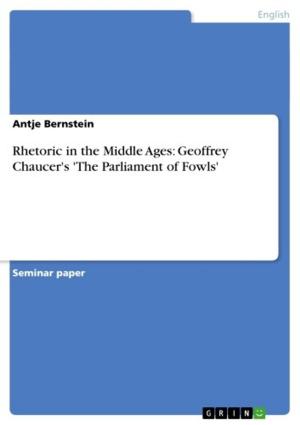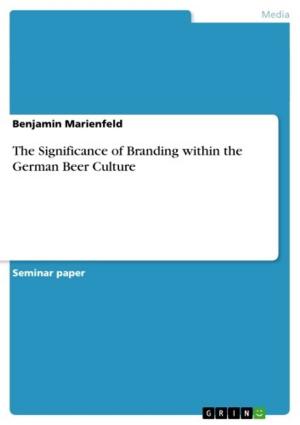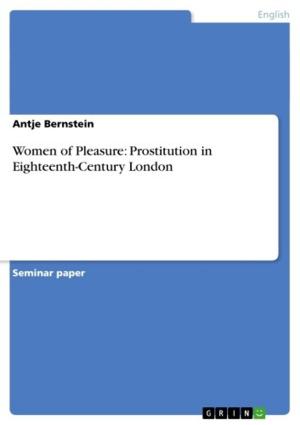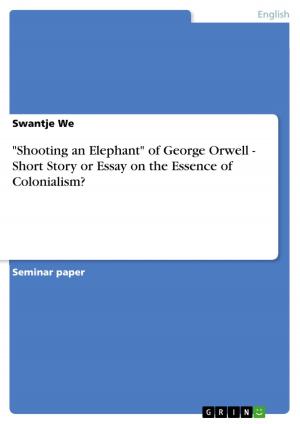Bed-Stuy in da Brownstone House:
Brooklyn Topographies as an Urban Metaphor of Deconstruction in Caribbean Immigration Narrative
Fiction & Literature, Literary Theory & Criticism, British| Author: | Irene Fowlkes | ISBN: | 9783640340309 |
| Publisher: | GRIN Publishing | Publication: | June 4, 2009 |
| Imprint: | GRIN Publishing | Language: | English |
| Author: | Irene Fowlkes |
| ISBN: | 9783640340309 |
| Publisher: | GRIN Publishing |
| Publication: | June 4, 2009 |
| Imprint: | GRIN Publishing |
| Language: | English |
Essay from the year 2006 in the subject English - Literature, Works, grade: B+, University of Paderborn, course: Literary Topographies: New York, language: English, abstract: For the purpose of a contribution to the critical text volume of the Afro-American diaspora,'Brown Girl, Brownstones' is read as a Bildungsroman, rather than an ethnic study, whereas certain terms of sociological discourse pertaining to class, gender and race are elaborated upon. The novel concerns the first generation Barbadian-American girl Selina Boyce, who grows up in the Bedford-Stuyvesant section of Brooklyn during the Depression and the Second World War. Exploring the immigrant experience of Selina's family through two major narrative strands, whereas the first primarily treats her parents' domestic conflict and the second is devoted to the protagonist's coming of age, the novel is held together by the artful depiction of New York City topographies. As characteristic of the entire story, the beginning is constituted by a powerful personification of the brownstone houses, which are typical for Bed-Stuy, as the neighborhood is affectionately called by locals; contributing to its nostalgic charm. Both, the structure and significance of the work are sustained by the creation of socio-psychological meaning through the relationship of the plot with its characters and spatial images that translate into symbolism. Whereas Selina's consciousness is primarily defined by the atmosphere of the city, her parent's attitudes are still influenced in various ways by their past childhood on the Caribbean islands. The family's search for a new home in the urban north of the United States is traced by highlighting the architectural metaphors of New York City in the novel. Special consideration is given to the beautiful Bed-Stuy brownstone story houses, Prospect Park, Fulton Street in downtown Brooklyn and industrial Williamsburg as well as bohemian Greenwich Village in Manhattan. Less a conceptualization of dualities, as it can be found often in the secondary literature about Paule Marshall's first work of prose, my interpretation aims to support the idea of an urban metaphor of deconstruction. Consequently, the romantic myth of New York City is put into question, as the protagonist rises to independence against the backdrop of development projects and embarks on her own version of the American dream.
Essay from the year 2006 in the subject English - Literature, Works, grade: B+, University of Paderborn, course: Literary Topographies: New York, language: English, abstract: For the purpose of a contribution to the critical text volume of the Afro-American diaspora,'Brown Girl, Brownstones' is read as a Bildungsroman, rather than an ethnic study, whereas certain terms of sociological discourse pertaining to class, gender and race are elaborated upon. The novel concerns the first generation Barbadian-American girl Selina Boyce, who grows up in the Bedford-Stuyvesant section of Brooklyn during the Depression and the Second World War. Exploring the immigrant experience of Selina's family through two major narrative strands, whereas the first primarily treats her parents' domestic conflict and the second is devoted to the protagonist's coming of age, the novel is held together by the artful depiction of New York City topographies. As characteristic of the entire story, the beginning is constituted by a powerful personification of the brownstone houses, which are typical for Bed-Stuy, as the neighborhood is affectionately called by locals; contributing to its nostalgic charm. Both, the structure and significance of the work are sustained by the creation of socio-psychological meaning through the relationship of the plot with its characters and spatial images that translate into symbolism. Whereas Selina's consciousness is primarily defined by the atmosphere of the city, her parent's attitudes are still influenced in various ways by their past childhood on the Caribbean islands. The family's search for a new home in the urban north of the United States is traced by highlighting the architectural metaphors of New York City in the novel. Special consideration is given to the beautiful Bed-Stuy brownstone story houses, Prospect Park, Fulton Street in downtown Brooklyn and industrial Williamsburg as well as bohemian Greenwich Village in Manhattan. Less a conceptualization of dualities, as it can be found often in the secondary literature about Paule Marshall's first work of prose, my interpretation aims to support the idea of an urban metaphor of deconstruction. Consequently, the romantic myth of New York City is put into question, as the protagonist rises to independence against the backdrop of development projects and embarks on her own version of the American dream.















